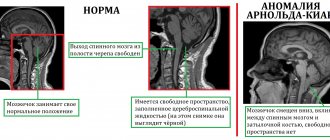Benign intracranial hypertension syndrome in children: diagnosis and treatment
A lot of controversy arises around the so-called intracranial hypertension syndrome.
Someone says that such a condition does not exist and doctors are allegedly engaged in pseudo-treatment, deceiving parents. Most often, this misinformation is carried out by doctors of related specialties themselves, and sometimes even directly by some pediatric neurologists. The purpose of this short article is to explain in an accessible form what this mysterious, ambiguous condition is - intracranial hypertension syndrome? To do this, I will rely primarily on scientific articles, the results of various studies, as well as my personal experience as a practicing neurologist at a medical center with almost 10 years of medical experience.
Symptoms of pathology
We often have to listen to parents complain that their child has such unhealthy signs as:
- tearfulness;
- restless sleep;
- decreased appetite;
- irritability.
Of course, these manifestations are not characteristic only of intracranial hypertension syndrome (ICH). Almost any illness can cause these symptoms. One can say even more, it is impossible to reliably diagnose ICH syndrome only on the basis of patient complaints. Any pain syndromes in children tend to generalize. Also, headaches in children, especially in the first years of life, are manifested by general reactions similar to the complaints described above, which complicates topical diagnosis.
Examination of the child is very important for a high-quality diagnosis of pathology. First of all, you should pay attention to such additional signs as:
- Enlarged, rounded head shape.
- Swelling and pulsation of the large fontanelle.
- Expansion of the vascular network at the temples, bridge of the nose, and around the eyes.
- Neck muscle tension.
- Graefe's symptom (manifestation of sclera between the upper eyelid and the iris of the eye, exophthalmos).
The baby's behavior also changes. He has a desire to lie on a cold surface, putting his head against it, he can touch, hit his head with his hand or a toy, both his own and someone else’s, hit his head on the floor or wall, or simply scratch behind the ear. Often, intracranial hypertension syndrome can be accompanied by nosebleeds.
Features of the disease
Information about the child’s life history, illness, and heredity is important for a specialist. The main cause of the development of ICH syndrome is perinatal hypoxic-ischemic damage to the central nervous system (CNS). Children with a burdened obstetric history are at risk for the development of intracranial hypertension. The course of ICH syndrome is chronic, with periods of exacerbation followed by periods of remission. Like any chronic disease, there is no point in trying to cure it completely. The main task of the doctor is to transfer the course of the disease to the stage of remission.
It should be understood that in the remission stage such a child is no different from a healthy peer. He is also well developed in psycho-speech and motor development. If this is not the case, then it is a different condition, but it is important to know that ICH syndrome does not cause delays in the development of the child. In medical practice, there are cases of the spread of ICH syndrome in one family (among siblings and cousins).
Diagnosis of the disease
In terms of instrumental confirmation of ICH in children, nowadays there are many neuroimaging methods, in particular:
- neurosonography (number 1 for children of the first year of life);
- computed tomography (CT);
- magnetic resonance imaging (MRI).
It is worth noting that none of these methods can directly determine the amount of intracranial pressure, but they can show indirect signs (expansion of the liquor spaces, dilation of the veins and venous sinuses of the brain). Most authors agree that for a reliable diagnosis of benign intracranial hypertension, a child needs a combination of three of the following four criteria:
- Increase in head circumference.
- The presence of ventriculomegaly (enlargement of the ventricles of the brain).
- Headaches or their equivalent in children under 3 years of age.
- Complicated obstetric history.
There are other syndromes with similar manifestations that require a different approach in terms of treatment and diagnosis. These include: the consequences of traumatic brain injury or neuroinfections, intracranial tumors and hematomas, the initial stage of occlusive hydrocephalus, which we will not dwell on in this article.
Treatment methods
So we found out that the child has ICH syndrome. What to do? First of all, don't panic! As noted above, developmental delays do not develop in children with this syndrome. The main problem is pain. To eliminate it, you should not use painkillers. It is necessary to dehydrate the body with diuretics. In particular, the drug Diacarb, by inhibiting the enzyme carbonic anhydrase, not only accelerates the excretion of cerebrospinal fluid, but also reduces its production. Do not try to prescribe medications to your child yourself! This should only be done by a qualified doctor. The inclusion of nootropic and vasoactive drugs in therapy increased the percentage of positive treatment outcomes in various studies.
Preventive measures
In addition to drug treatment, it is necessary to follow certain rules necessary to prevent exacerbation of ICH syndrome:
- Any blows, even minor ones, to the child’s head are undesirable.
- Correct sleep and wakefulness patterns.
- Do not allow your child to stay in noisy rooms for a long time.
- Limit water load in the evening.
- Do not walk for a long time in the sun, especially without a hat.
And, perhaps, the best information: the manifestations of ICH syndrome become less frequent with age and can often gradually disappear forever. That is why the incidence of benign intracranial hypertension in adults is extremely low.
Kabardiev Alimkhan Arslanovich, pediatric neurologist.
Works in a clinic of a medical network in the city. Khasavyurt at the address: st. Abubakarova, 9a.
Opening hours: daily, Monday to Saturday - from 13.00 to 17.00.
Phone numbers for inquiries and appointments: +7
Ventricular system of the brain
The ventricles of the brain are several interconnected collectors in which the formation and distribution of liquor fluid occurs. Liquor washes the brain and spinal cord. Normally, there is always a certain amount of cerebrospinal fluid in the ventricles.
Two large collectors of cerebrospinal fluid are located on either side of the corpus callosum. Both ventricles are connected to each other. On the left side is the first ventricle, and on the right is the second. They consist of horns and a body. The lateral ventricles are connected through a system of small holes to the 3rd ventricle.
In the distal part of the brain, between the cerebellum and the medulla oblongata, there is the 4th ventricle. It is quite large in size. The fourth ventricle is diamond-shaped. At the very bottom there is a hole called the diamond-shaped fossa.
Proper functioning of the ventricles allows cerebrospinal fluid to enter the subarachnoid space when necessary. This zone is located between the dura mater and the arachnoid membrane of the brain. This ability allows you to maintain the required volume of cerebrospinal fluid in various pathological conditions.
In newborn babies, dilatation of the lateral ventricles is often observed. In this condition, the horns of the ventricles are enlarged, and increased accumulation of fluid in the area of their bodies may also be observed. This condition often causes both left and right ventricle enlargement. In differential diagnosis, asymmetry in the area of the main brain collectors is excluded.
What are the ventricles of the brain, their role
The ventricles of the brain are strips of tissue necessary for the deposition of cerebrospinal fluid. External and internal factors can lead to their increase in volume. The lateral ventricles are the largest. These formations are involved in the formation of cerebrospinal fluid.
Asymmetry is a condition in which one or both cavities are enlarged to varying degrees.
Lateral . The ventricles are the most voluminous, and they contain cerebrospinal fluid. They connect to the third ventricle via the interventricular foramina. Third . Located between the visual tuberosities. Its walls are filled with gray matter. Fourth . Located between the cerebellum and medulla oblongata.
Symptoms and diagnosis of the disorder
In adults, ventricular asymmetry rarely causes symptoms. However, in some cases, this anomaly can cause the following symptoms:
- nausea and vomiting; dizziness; headache; feeling of heaviness and fullness of the head; apathy; feeling of anxiety.
In addition to these symptoms, the picture of the disease can be supplemented by symptoms of diseases that caused ventricular asymmetry.
Such symptoms include cerebellar disorders, paresis, cognitive impairment or sensory disorders.
In infants, symptoms depend on the severity of the pathology. In addition to general discomfort, symptoms such as throwing back the head, regurgitation, increased head size and others may occur.
Symptoms of the pathology also include strabismus, refusal to breastfeed, frequent crying, anxiety, tremors, and decreased muscle tone.
However, quite often the pathology does not cause characteristic symptoms and can only be detected after an ultrasound scan.
About the consequences
There is no direct connection between the visible difference and the functional asymmetry of the cerebral hemispheres. Sometimes the opposite pattern occurs: for example, with epilepsy, patients experience sensory seizures with loss of sensitivity in the right extremities, but in the place where the source should be - in the sensory zone of the posterior central gyrus of the cortex on the left - there are no disturbances.
The most significant disorder of asymmetry of brain structures is a violation of liquorodynamics. If hydrocephalus exists, it may again be asymptomatic. This applies to normal pressure hydrocephalus, when there is an excess of cerebrospinal fluid, but only quantitatively, its pressure is normal. But if the cerebrospinal fluid pressure increases, then a syndrome of increased intracranial hypertension occurs. It is manifested by the following disorders:
- persistent, diffuse headaches, especially in the morning;
- improvement in condition after lunch and in the evening;
- progressive decrease in vision;
- the occurrence in severe cases of vomiting, which may or may not be accompanied by nausea;
- the appearance of congestive optic discs in the fundus.
If such symptoms occur, you should urgently consult a neurologist.
In mild cases, conservative treatment leads to recovery, but sometimes surgery is required. In this case, the interhemispheric asymmetry of the brain will remain, but nothing will bother the patient, since the cerebrospinal fluid will be drained into the abdominal cavity through the ventrpiculoperitoneal shunt.
In conclusion, it should be noted that early monitoring of increased intracranial pressure in childhood always bears fruit, since atrophy of the cerebral cortex can be avoided in a timely manner. If there are no symptoms, then it is enough to observe the children with a neurologist. Direct measurement of liquor pressure is only possible by drilling a hole in the head and installing a pressure gauge (literally), but indirect signs make it possible to fairly well assess the degree of violations and take the necessary measures.
What kind of disease is this
A pathological process affecting the fetal brain, in which the ventricles of the brain swell (change their shape), is called ventriculomegaly. Pathology has a negative impact on the developing nervous systems of the body (central and peripheral). As a result of ventriculomegaly, the fetus suffers from:
- spinal cord;
- brain;
- nerve processes and roots;
- autonomic nervous system.
Not only individual organs, but also entire body systems suffer from excess fluid.
The cerebral ventricles communicate with each other through canals. They perform a very important function for the body - they synthesize cerebrospinal fluid (CSF). Normally and in the absence of abnormalities, this fluid flows into a certain space called the subarachnoid space. If an anomaly is present, then the outflow stops, fluid (CSF) accumulates in the ventricles, creating many problems for the baby.
There are three degrees of severity of ventriculomegaly:
- light;
- average;
- heavy.
With a mild degree, the lesions are isolated, quickly respond to treatment and pass without consequences for the baby. Complex drugs are not required, the ventricles quickly return to normal.
The average degree implies an increase in the ventricles (one or more) up to 15 mm inclusive. This happens because the natural outflow of fluid is disrupted. The functionality of the ventricles is also impaired.
With severe ventriculomegaly, the ventricles are greatly enlarged (up to 21 mm) due to the accumulation of cerebrospinal fluid in them. Serious treatment and monitoring of the condition and intrauterine development of the baby is required.
Causes of ventriculomegaly in the fetus
Ventriculomegaly is a rather dangerous disease that can provoke the death of the fetus in the womb, or manifest itself in the form of anomalies (mental and physical disorders), as a prospect - disability in the future. In order, if possible, to protect the baby from the harmful consequences of ventriculomegaly, it is necessary to select the most effective treatment, identifying the real causes of this pathology. These reasons may be associated with genetic abnormalities of the parents or manifest themselves independently. Ventriculomegaly in the fetus can be caused by the following reasons:
- the age of the pregnant woman is over 35 years;
- abnormal genes and chromosomes in expectant mothers;
- the presence of pathological processes during pregnancy;
- all kinds of infections (including intrauterine ones);
- obstructive fetal hydrocephalus;
- physical injuries;
- strokes;
- periventricular leukomalacia;
- lissencephaly.
The threat can be detected as early as 17 weeks of pregnancy using ultrasound screening.
From the 17th to the 34th week, the doctor pays special attention to the development of the brain, as well as the size of its ventricles. Ventriculomegaly is indicated by an increase in one or more ventricles, ranging from 12 mm to 20 mm
If ventriculomegaly is suspected, the doctor recommends undergoing additional tests and repeating the ultrasound after another 2 weeks. It is also mandatory for the expectant mother to visit a geneticist, who will determine whether the pathology is congenital or caused by injury or infection. The karyotyping procedure is also shown for a baby in the womb.
Consequences of ventriculomegaly
Ventriculomegaly in the fetus - the consequences of this disease, which began in the womb, can be very severe, starting with the death of the child in the womb (due to developmental defects), premature birth (accounts for up to 4% of all known cases), severe and disability.
If a genetic factor plays a role in the appearance of ventriculomegaly, then the following deviations and syndromes are possible:
- Down syndrome;
- hydrocephalus;
- Patau;
- Edwards;
- Turner (with gonadal dysgenesis);
- vascular malformations of the brain;
- mental retardation;
- retardation in physical development.
It has been noted that female infants are more susceptible to anomalies and defects as a result of ventriculomegaly, compared to male infants.
Despite everything, children born with a similar diagnosis have a very good chance of further normal life. So, in 80% of cases out of a hundred, babies outgrow this condition and subsequently develop fully without deviations.
Among all known cases of ventriculomegaly, 10% of infants are susceptible to serious pathologies. Deviations of moderate severity were noticed in 8% of children born with this diagnosis.
Dilatation of the lateral ventricles of the brain - is asymmetry dangerous?
There are a number of anatomical features of the human brain. In some cases, some nuances of its structure that differ from the norm are considered physiological and do not require treatment.
However, certain deviations from the norm can cause the development of neurological pathologies. One such condition is asymmetry of the lateral ventricles of the brain. This disease may not cause clinical symptoms, but in some cases it indicates the presence of a number of diseases.









